Cooperative Communication is a scheme that combines the benefits of MIMO systems with relay techniques and forms a virtual distributed MIMO system. The relaying techniques used in this paper are Amplify and Forward and Decode and Forward. The performance of Amplify and Forward protocol is analysed using single relay and two relays and compared to direct link. The QPSK modulation technique is used and signals are combined using maximum ratio combining at receiver. The performance of Decode and Forward protocol is also analysed using a number of relays. The signal is decoded and re-encoded at one relay and how the signal is transmitted when error occur and when error does not occur has been shown and its comparison to direct link has been done.
Keywords |
| Amplify and Forward, Cooperative Communication, Decode and Forward, MIMO, QPSK. |
INTRODUCTION |
| The idea of Cooperation firstly was presented by Vander Meulen 1971.The foundation of the relay channel was
established there. In Cooperative communication the neighbouring node overhear the source’s signal due to broadcast
nature of wireless medium and sends the information to the destination. In this way, the cooperating nodes create a
virtual antenna array [1]. With cooperation it is possible to obtain the cooperative diversity benefits of MIMO systems
without the cost of having a physical antenna array at each terminal. Thus, because of these benefits cooperative
communication is a promising technique which can be widely used in next-generation wireless networks [2]. |
| When a mobile user wishes to communicate with the base station, but if the link between them is too weak
then the nearby mobile user cooperates shares their antenna and aids n direct communication. Using relays the coverage
and capacity of cellular network can be increased without any increase in extra bandwidth and mobile transmit power
[3].The transmission in which a source and relay cooperate to send a message to a destination is cooperative
transmission and it can provide spatial diversity against fading in wireless networks. The analytical expressions for the
error probability of amplify-and-forward (AF), decode-and-forward (DF), and a new hybrid AF/DF relaying protocol in
Rayleigh fading channels has been derived for systems using strong forward error correction [4]. |
| The Cooperative Communication can be utilized to mitigate channel estimation error which is the main cause
of performance degradation. Two performance criteria used to study it are outage probability and signal to noise gap
ratio. Using Cooperative Communication the SNR gap ratio is lowered and outage probability is also reduced [5].The
performance of fixed decode-and-forward cooperative networks with relay selection over independent but not
identically distributed for severity parameter m was analysed. Closed-form expressions the symbol error probability
and the outage probability are derived using the statistical characteristic of the signal-to-noise ratio [6]. |
| The rest of the paper is organized as follows. In section II Proposed model, amplify and forward protocol and decode
and forward protocol are explained. In section III Experiments and Results are presented. In section IV Conclusion is
given. |
PROPOSED MODEL |
| The Cooperative communication system consists of a source S, destination D and a number of relays are placed in
between of them. Each node is equipped with single antenna and all of them can not transmit or receive at the same
time. The fading channel coefficients between source and destination, source and relay and relay and destination are
denoted by hsd, hsr and hrd respectively, where they are modelled as Nakagami-m distributed random variables with
parameters shaping factor, m and spreading factor, Ω. The relays are using parallel transmission topology. Thus, the
probability density function is given by |
 |
| Thus the system models for Amplify and Forward cooperative communication and Decode and Forward cooperative
communication is as shown in Fig 1 and Fig 2. |
| A. Amplify and Forward protocol |
| As shown in Fig. 1 a source is transmitting data to the destination. The transmission of the data from the source to the
destination terminal is accomplished in two phases. In the first phase, the source broadcasts data to the destination and
also to relay. In the second phase, the relay after receiving data amplifies the received data and retransmits it to the
destination. The relay receives the information signal appended by the channel gain and noise. The amplified signal is
sent to the destination. Now, the receiver can decode the combined signal using Maximal Ratio Combining (MRC) [7].
In the first phase, the source broadcasts its information with transmission power P to destination and relays |
 (2) (2) |
 (3) (3) |
| Then, all the relays will forward the scaled versions of the received signal to D in the matched phases. Thus, at the
destination terminal, the received signals from the relay R can be written as |
 (4) (4) |
| where, βk = √ [Pk / (P |hsr|2
+ No)] and Pk is the transmit power of any relay. The source-to-relay and the relay-to
destination paths are separately estimated [8]. |
| B. Decode and Forward protocol |
| In decode and forward protocol processing occurs at the relay node. The relay decodes the received signal, re-encode it,
and then retransmit it to the receiver. The decoded signal at the relay may be incorrect. If an incorrect signal is
forwarded to the destination, the decoding at the destination is meaningless.
The received signal at the destination in Phase 2 can be modelled as |
 (5) (5) |
 (6) (6) |
| With knowledge of the channel coefficients hsd(between the source and the destination) and hrd (between the relay
and the destination), the destination decodes the transmitted symbols and the signals are received asYsd from the
source and Yrd,from the relay. As shown in Fig.2 the decoding of signal occurs at R2. Here, the signal is decoded and
checked for error if error=1 then the signal is transmitted by R3 to destination and if error=0 then the signal is reencoded
and transmitted through R1 to destination. |
| C. SNR and BER analysis |
| The equivalent SNR of MRC output is |
 (7) (7) |
| It can be transformed as |
 (8) (8) |
| Where γ1and γ2 are |
 (9) (9) |
 (10) (10) |
 (11) (11) |
 (12) (12) |
| Thus, |
 |
| γ1 is the SNR of MRC output formed by signal’s transmitting from source node to destination node. is the SNR of
MRC output formed by signal’s transmitting through the i-th relay-assisted channel. n is the total number of relay
nodes. is the total SNR of all relay links. can be tightly upper bounded as |
 |
which is the harmonic mean of two exponential random variables  If we
approximate the SNR a If we
approximate the SNR a  The conditional SER of AF cooperation systems with MPSK
modulations can be given as follows [ The conditional SER of AF cooperation systems with MPSK
modulations can be given as follows [ |
 |
EXPERIMENTS AND RESULTS |
| The performance of Amplify and Forward protocol is analyzed when direct link is used for transmission of signals,
when single relay is used and when two relays are used and all signals are combined at receiver. Matlab 7.8 software
platform is use to perform the experiment. |
| This is done by taking different values of shape parameter i.e. m=1 and m=2. The graph shows that BER is reduced
when single relay is taken as compared to direct link. The performance also improves when two relays are taken as
compared to direct link. Using two relays instead of one provides a diversity gain. |
| The performance of Decode and Forward protocol is analysed when direct link is used for transmission of signals
and compared after applying decode and forward at decoding relay. The results have been analysed taking different
values of m i.e. m=1 and m=2. |
| In Fig.3 direct link is compared with amplify and forward with single relay. In Fig.4 direct link is compared with
amplify and forward with two relays. In Fig.5 direct link, amplify and forward with single relay and with two relays are
compared for m=1. In Fig.6 direct link, amplify and forward with single relay and with two relays are compared for
m=2. In Fig.7 and Fg.8 decode and forward protocol is compared with direct link for m=1 and m=2. |
CONCLUSION |
| In this paper the performance of Amplify and Forward and Decode and Forward cooperative communication
systems is analysed. It is seen that in Amplify and Forward when single relay is used instead of direct link, there is a
reduction in bit error rate. When two relays are used instead of direct link, there is a reduction in bit error rate. Thus,
using two relays instead of single relay is providing improved performance. Moreover, the performance also improves
when m=2 compared to m=1. |
| It is also observed that the performance of Decode and Forward cooperative communication systems improves
compared to direct link. Moreover, the performance also improves when m=2 compared to m=1. |
Tables at a glance |
 |
 |
| Table 1 |
Table 2 |
|
Figures at a glance |
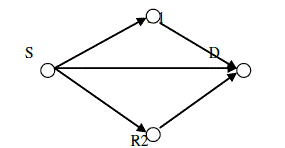 |
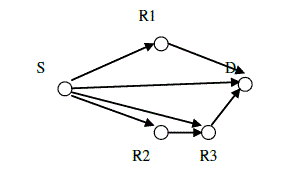 |
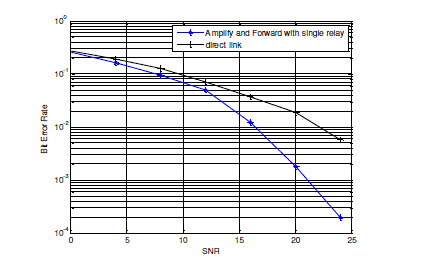 |
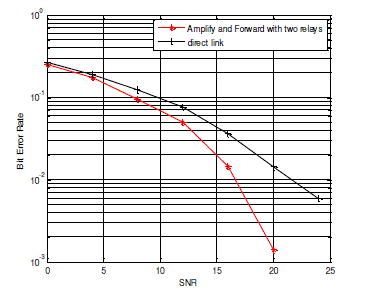 |
| Figure 1 |
Figure 2 |
Figure 3 |
Figure 4 |
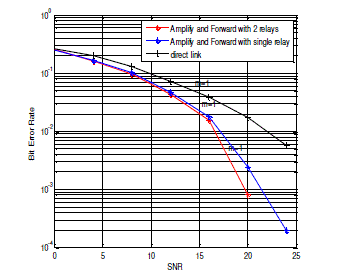 |
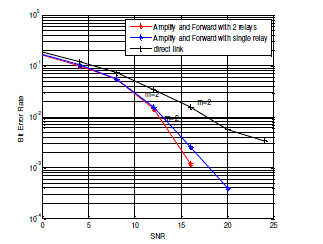 |
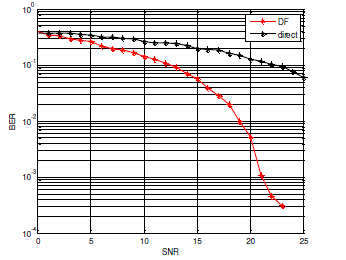 |
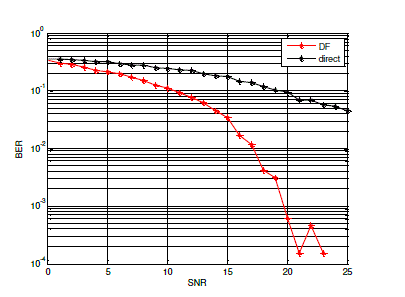 |
| Figure 5 |
Figure 6 |
Figure 7 |
Figure 8 |
|
References |
- Y.W. Peter Hong, Wan-Jen Huang & C.C. Jay Kuo, ?Cooperative Communication and Networking: Technologies and System Design? Springer, ISBN: 1441971939, 2010.
- Fitzek, Frank H. P.; Katz, Marcos D., ?Cooperation in Wireless Networks: Principles and Applications? Real Egoistic Behavior is to Cooperate!?,Springer, 2006.
- J. N. Laneman, D. N. C. Tse, and G. W. Wornell, ?Cooperative diversity in wireless networks: efficient protocols and outage behavior?. IEEE Transactions on Information Theory, 50(12):3062?3080, pp. 3062-3080, December 2004.
- Souryal M.R., ?Performance of AF and DF relaying in Rayleigh fading with Turbo codes?, IEEE conf. publication May 2006.vol.4, pp.4.
- A. S. Ibrahim and K. J. R. Liu, ?Mitigating channel estimation error via cooperative communications,? in Proc. IEEE Int. Conf. on Commun.ICC?09, pp.1-5.June 2009.
- Duong T.Q., Vo Nguyen, Zepernick H., ?On the performance of selection decode-and-forward relay networks over Nakagami-m fading channels?, communication letters IEEE, vol.13, issue 3, pp.172-174, March 2009.
- MischaDohler, Yonghui, ?Cooperative communication Hardware, Channel and Phy?, John wiley and sons, Unversty of Sydney, Jan 2010.
- Rahat Al Khan, Muhammad Abdul Aleem, Asad Ali Shaikh, ?Performance Analyss of Cooperative Communcation Protocols?, JETCIS, vol.3, No.7, July 2012.
- Lei Xu, Hongwei Zhang, Xiaohui Li, Xianliang Wu, ?Analysis of asymptotic approximation SER for TDMA relay protocol in cooperative communication networks?,2011.
- S.Yang, and J. C. Belfiore, ?Towards the optimal amplify-and-forward cooperative diversity scheme,? IEEE Trans. Inf. Theory, vol. 53, pp. 3114-3126, Sep. 2007.
- A.Sendonaris, E.Erkip and B Aazhang, ?User Cooperative diversity part-I and part-II?, IEEE Trans., commun. vol.51, no.11, pp.1927-48, Nov 2003.
- K. J. Rayliu, Ahmed K. Sadek, Weifengsu, Andres Kwasinski, ?Cooperative Communications and Networking?. Cambridge University Press, 2009 ISBN-13 978-0-511-46548-2.
- T.M.Cover and A.A.E. Gamal, ?Capacity theorems for relay channel?, IEEE Trans info Theory,vol.25, no.5,pp. 572-84,Sept 1979.
- Yan Li and Shalinee Kishore ?Asymptotic Analysis of Amplify-and-Forward Relaying in Nakagami-Fading Environments?, IEEE Transactions on Wireless Communications, Vol.6, No. 12, pp. 4256-4262, December 2007.
- Murat Utsyal, ?Cooperative Communications for Improved Wireless Network Transmission: Framework for Virtual Antenna Array Applications?,2010.
|